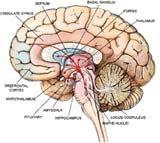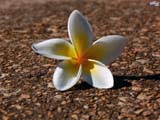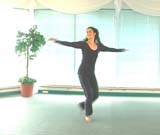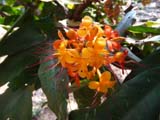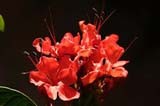Case study
Flower essences for a case of chronic stress
Chronic stress is the response to emotional pressure suffered for a prolonged period over which an individual perceives he or she has no control. It involves a release of corticosteroids as a response from the endocrine system. If this continues for a long time, the individual’s physical and mental health deteriorates.
In humans, symptoms of chronic stress can vary from anxiety, depression, social isolation, headache, abdominal pain or lack of sleep to back pain and difficulty in concentrating.
Biology
Animals exposed to distressful events over which they have no control respond by the release of corticosteroids (1,2). These, if prolonged, lead to structural changes in their brains. Changes happen to neurons and their synapses in the hippocampus(3) and medial prefrontal cortex (4). These produce impairments in the working memory (5) and spatial memory (5), as well as leading to increased aggression (6).
Linked to impairment of the medial prefrontal cortex are deficits in that part of the striatum. This can bias decision-making strategies, as affected individuals shift from flexible behaviour to one dominated by habit (7).
If someone is under stress for long periods of time they may have adverse health effects later on, such as hypertension and increased risk of cardiovascular disease (8).
Treatment
There are a variety of methods to control chronic stress, including exercise, healthy diet, stress management, relaxation techniques, adequate rest, and relaxing hobbies.
Psychological treatments
(i) Transactional mode
Richard Lazarus and Susan Folkman suggested in 1984 that stress can be thought of as resulting from an “imbalance between demands and resources” or as occurring when “pressure exceeds one’s perceived ability to cope”. Stress management was developed and premised on the idea that stress is not a direct response to a stressor but rather one’s resources and ability to cope, mediate the stress response and be amenable to change, thus allowing stress to be controllable (9).
(ii) Health realisation/innate health model
In the health realisation/innate health model of stress, instead of focusing on the individual’s appraisal of so-called stressors in relation to his or her own coping skills (as the transactional model does), the focus is on the nature of thought. The health realisation/innate health model believes that it is ultimately one’s thought- processes that determine the response to potentially stressful external circumstances. In this model, stress results from appraising oneself and one’s circumstances through a mental filter of insecurity and negativity, whereas a feeling of well-being results from approaching the world with a ‘quiet mind’ (10,11).
The case of Jessie
Jessie is a 38 year-old American New Yorker who was brought accidentally into my office by a friend. She was travelling in India as a way out of the chronic stress facing her in her own country. In her own words:
“I am an exclusive person. I am moody. Basically I am healthy and give priority to my body and physical fitness.
There is however an anxiety deep inside me. My mother is the same. I think all the people in New York are like this.
I am the first of two siblings. I have a younger brother with whom I do not get along well. According to me, he is very self-centred.
Three years back, I got burnt out working in New York where I have lived for 10 years. I left 2½ years ago and travelled all over the world but my physical body has not recovered.
I have been suffering from headaches, once or twice a week for the last 15 years; aching muscles, stiffness in the body, pain in the neck, a cramping pain with tingling in the shoulders, restlessness in the legs on sitting too long and low energy unless I eat every two to three hours for the last 3 years. All this becomes worse with sadness or anxiety. I wake up tired even after 10 hours of sleep. I get extremely tired by 10 pm.
I have been diagnosed as having chronic stress syndrome. I am living on my reserves. I desperately need a job but cannot find one. I have done an MA in Post-War Recovery Management.
The only thing that really helps me get out of my anxiety is exercising a lot.”
Selection of essences
Jessie’s story was only a fragment of the information I was receiving. Her body language was speaking to me of insecurity and a lack of love. But for selecting the flower, I had to go deeper. What was her special psychic (soul) quality? What flower resonated with her innermost essence? What was hiding her truth from herself?
My way, in all cases, is to try to become one with the person in front of me. Thereby a spontaneous knowledge gradually emerges of what is needed to bring back joy, peace, light, love and harmony. This way precludes analysis and relies on an inner sense. Through this way I came upon two flower essences whose vibration could help her.
They were Saraca indica or ‘Without Grief’ and Clerodendrum splendens or ‘Right Attitude Established’.
Effect of the essences
She first came on 31. 01.08 and the two essences were given to her. They were to be taken as 4 drops, 4 times a day. She met me again on the 19th and said:
“I feel good with the flowers. There is a vibration in the heart. It seems to coat the insides of the stomach. The aching comes and goes but is much less. There is no restlessness in the legs. I have very few headaches. The neck pain has decreased. There is no shoulder pain or tingling. I notice silly repetitive thoughts troubling me. Yet I wake up fresh and happy. I have been very low only once or twice. The energy is good. I still need to eat every 2-3 hours.
She then left Pondicherry. She met me again on 05.03.08. During the time she was away she did not stop taking the essences! She reported:
“I still feel good. My energy is surprisingly good. My mood can switch very easily from good to bad and vice versa. The mind is overactive. I was sad twice only. I am now eating normally. There are no body aches. The neck is stiff and tingling sometimes.”
I noticed that she was different. The restlessness of the body was gone. She looked more at peace and her speech was not so hurried.
When she came back in August she was very well and wanted to continue with the remedies.
She got a job in London and came back in March.
On 05.03.09 she said, “I am happy. All the physical problems have almost disappeared. I am calmer and less anxious. Yet I am confused and lack a clear purpose in my life.”
What I sensed was that the peacefulness was still there. A joy was coming back. Her body language was restful.
Reflections
1. This case showed me once again the power of these essences.
The patient did not have any personal contact with me. She did not have any special trust in me other than being recommended by a friend. She, who had been against medication of any kind, continued taking these essences because they consistently provided relief. These essences clearly work independently of all personal bias or affiliation.
2. It gave me a psychological insight into the problem (or cause) of her chronic stress. Chronic stress has deeper dimensions that need to be understood.
According to the innate health model, stress results from appraising oneself and one’s circumstances through a mental filter of insecurity and negativity. Perhaps the essence of ‘Right Attitude Established’ cleared this filter so that she could look at life and the world without getting anxious and stressed.
But behind this mental filter of insecurity and negativity I also sensed a deep wound so I also gave her ‘Without Grief’ which brought back her mental equilibrium.
3. I understood that the physical body responds to inner states also.
The mind-body model can be extended to a state beyond, where being in touch with the eternal part of oneself, one radiates happiness and can transcend cultural patterns. The flower essences have no physical substance. They are physically only water carrying different qualities. In my experience, again and again, by their simple presence they bring joy, peace, light, love and harmony. These qualities come first, but a psychological or physical change may then emerge, depending on the level of the person’s awareness.
4. Chronic stress was relieved for Jessie but she had to look for a purpose in life.
This case enlarged for me the scope of a true physician. Perhaps a true healer is someone who can go beyond frameworks and help a person settle into the reason for their being on this earth!
References
1. Sapolsky, R.M. Why zebras don’t get ulcers: an updated guide to stress, stress related diseases, and coping. W. H. Freeman, 2008, (2nd Rev Ed.).
2. McEwen, B.S. Physiology and neurobiology of stress and adaptation: central role of the brain. Physiol Rev 2007; 87 (3): 873-904. http://physrev.physiology.org/cgi/reprint/87/3/873
3. Sousa, N., Lukoyanov, N.V., Madeira, M.D., Almeida, O.F., Paula-Barbosa, M.M. Reorganization of the morphology of hippocampal neurites and synapses after stress-induced damage correlates with behavioral improvement. Neuroscience2000; 97 (2): 253-66.
4. Radley, J.J., Sisti, H.M., Hao, J., Rocher, A.B., McCall, T., Hof, P.R., McEwen, B.S., Morrison, J.H. Chronic behavioral stress induces apical dendritic reorganization in pyramidal neurons of the medial prefrontal cortex. Neuroscience 2004; 125 (1): 1-6.
5. Mizoguchi, K., Yuzurihara, M., Ishige, A., Sasaki, H., Chui, D.H., Tabira, T. Chronic stress induces impairment of spatial working memory because of prefrontal dopaminergic dysfunction. J Neurosci 2000; 20 (4): 1568-74. http://www.jneurosci.org/cgi/reprint/20/4/1568.
6. Mineur, Y.S., Prasol, D.J., Belzung , C., Crusio, W.E. Agonistic behavior and unpredictable chronic mild stress in mice. Behavior Genetics Sept. 2003; 33 (5): 513-9. http://www.kluweronline.com/art.pdf?issn=00018244&volume=33&page=513, retrieved 16-08-09.
7. Dias-Ferreira, E., Sousa, J.C., Melo, I., Morgado, P., Mesquita, A.R., Cerqueira, J.J., Costa, R.M., Sousa, N. Chronic Stress causes frontostriatal reorganization and affects decision-making. Science 2009; 325 (5940): 621-5. (doi:10.1126/science.1171203. PMID 19644122).
8. Blascovich, J., Spencer, S.J., Quinn, D. M., Steele, C. M. African Americans and high blood pressure: the role of stereotype threat. Psychological Science 2001; 13(3): 225-9.
9. Sousa, N., Lukoyanov, N.V., Madeira, M.D., Almeida, O.F., Paula-Barbosa, M.M. Reorganization of the morphology of hippocampal neurites and synapses after stress-induced damage correlates with behavioral improvement. Neuroscience 2000; 97 (2): 253-6. (doi:10.1016/S0306-4522(00)00050-6. PMID 0799757).
10. Radley, J.J., Sisti, H.M., Hao, J., Rocher, A.B., McCall, T., Hof, P.R., McEwen, B.S., Morrison, J.H. Chronic behavioral stress induces apical dendritic reorganization in pyramidal neurons of the medial prefrontal cortex. Neuroscience 2004; 125 (1): 1-6 (doi:10.1016/j.neuroscience. 2004.01.006. PMID 15051139).
11. Mizoguchi, K., Yuzurihara, M., Ishige, A., Sasaki, H., Chui, D.H., Tabira, T. Chronic stress induces impairment of spatial working memory because of prefrontal dopaminergic dysfunction. J Neurosci 2000; 20 (4): 1568-74. http://www.jneurosci.org/cgi/reprint/20/4/1568.
Dr. Vandana has been working with many flowers, to which the Mother gave spiritual significances, for the last 22 years.
Share with us (Comments,contributions,opinions)
When reproducing this feature, please credit NAMAH,and give the byline. Please send us cuttings.

